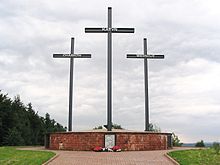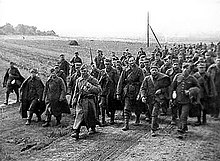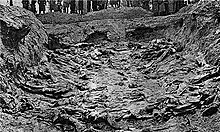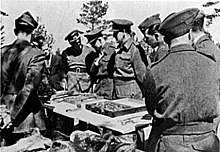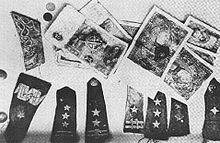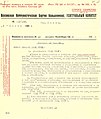The term "Katyn massacre" originally referred specifically to the massacre at Katyn Forest, near the villages of Katyn and Gnezdovo (ca. 19 kilometres (12 mi) west of Smolensk, Russia), of Polish military officers in the Kozelsk prisoner-of-war camp. This was the largest of the simultaneous executions of prisoners of war from geographically distant Starobelsk and Ostashkov camps,[9] and the executions of political prisoners from West Belarus and West Ukraine,[10] shot at Katyn Forest, at the NKVD headquarters in Smolensk, at a Smolensk slaughterhouse,[1] and at prisons in Kalinin (Tver), Kharkov, Moscow, and other Soviet cities.[4] The Belorussian and Ukrainian Katyn Lists are NKVD lists of names of Polish prisoners to be murdered at various locations in Belarus and Western Ukraine.[4] The modern Polish investigation of the Katyn massacre covered not only the massacre at Katyn forest, but also the other mass murders mentioned above. There are Polish organisations such as the Katyn Committee and the Federation of Katyn Families, which again are inclusive of victims of the various mass murders at the various locations.[4]
Nazi Germany announced the discovery of mass graves in the Katyn Forest in 1943. The revelation led to the end of diplomatic relations between Moscow and the London-based Polish government-in-exile. The Soviet Union continued to deny responsibility for the massacres until 1990, when it officially acknowledged and condemned the perpetration of the killings by the NKVD,[4][11][12] as well as the subsequent cover-up.[13]
An investigation conducted by the Prosecutor's General Office of the Soviet Union (1990–1991) and the Russian Federation (1991–2004), has confirmed Soviet responsibility for the massacres. It was able to confirm the deaths of 1,803 Polish citizens but refused to classify this action as a war crime or an act of genocide. The investigation was closed on grounds that the perpetrators of the massacre were already dead. Since the Russian government does not classify the dead as victims of Stalinist repression, formal posthumous rehabilitation is not possible.[14] Memorial issued a statement which declared "this termination of investigation is inadmissible" and that their confirmation of only 1,803 people killed "requires explanation because it is common knowledge that more than 14,500 prisoners were killed."[15]
Contents[show] |
[edit] Background

The Red Army advanced quickly and met little resistance, as Polish forces facing them were under orders not to engage the Soviets. Between 250,000[17] and 454,700[18] Polish soldiers and policemen had become prisoners and were interned by the Soviet authorities. About 250,000 were set free by the army almost on the spot, while 125,000 were delivered to the internal security services (the NKVD). The NKVD, in turn, quickly released 42,400 soldiers. The approximately 170,000 released were mostly soldiers of Ukrainian and Belarusian ethnicity serving in the Polish army. The 43,000 soldiers born in West Poland, then under German control, were transferred to the Germans.
By November 19, the NKVD had about 40,000 Polish POWs: about 8,500 officers and warrant officers, 6,500 police officers and 25,000 soldiers and NCOs who were still being held as POWs.[19]
According to estimates by IPN, roughly 320,000 Polish citizens were deported to the Soviet Union (data officially released in 2009, earlier estimates made before Soviet archives became accessible were significantly higher).[20] IPN estimates the number of Polish citizens that perished under the Soviet rule during World War II at 150,000.[20] Of the 10,000-12,000 Poles sent to Kolyma in 1940-1941, most POWs, only 583 men survived, released in 1942 to join the Polish Armed Forces in the East.[21] According to records kept in the Special Colonies Department of the Gulag, 381,000 Polish civilians from annexed eastern parts (so-called "Kresy") of Poland were deported between February 1940 and June 1941 as "specially displaced people".[22] According to the Index of the Repressed, during the war and after 1944, 570,387 Polish citizens had been subjected to some form of Soviet repression.[23]
As early as September 19, the People's Commissar for Internal Affairs and First Rank Commissar of State Security, Lavrentiy Beria, ordered the NKVD to create the Administration for Affairs of Prisoners of War and Internees to manage Polish prisoners. The NKVD took custody of Polish prisoners from the Red Army, and proceeded to organise a network of reception centers and transit camps and arrange rail transport to prisoner-of-war camps in the western USSR. The largest camps were located at Kozelsk (Optina Monastery), Ostashkov (Stolbnyi Island on Seliger Lake near Ostashkov) and Starobelsk. Other camps were at Jukhnovo (rail station "Babynino"), Yuzhe (Talitsy), rail station "Tyotkino" (90 kilometres (56 mi) from Putyvl), Kozelshchyna, Oranki, Vologda (rail station "Zaonikeevo") and Gryazovets.[24]
Kozelsk and Starobelsk were used mainly for military officers, while Ostashkov was used mainly for Polish boy scouts, gendarmes, police and prison officers. Prisoners at these camps were not exclusively military officers or members of the other groups mentioned but also included Polish intelligentsia. The approximate distribution of men throughout the camps was as follows: Kozelsk, 5,000; Ostashkov, 6,570; and Starobelsk, 4,000. They totaled 15,570 men.[9]
Once at the camps, from October 1939 to February 1940, the Poles were subjected to lengthy interrogations and constant political agitation by NKVD officers such as Vasily Zarubin. The prisoners assumed that they would be released soon,[25] but the interviews were in effect a selection process to determine who would live and who would die.[1] According to NKVD reports, if the prisoners could not be induced to adopt a pro-Soviet attitude,[9] they were declared "hardened and uncompromising enemies of Soviet authority."[1]
On 5 March 1940, pursuant to a note to Stalin from Beria, four members of the Soviet Politburo - Stalin, Vyacheslav Molotov, Kliment Voroshilov and Anastas Mikoyan - signed an order to execute 25,700 Polish "nationalists and counterrevolutionaries" kept at camps and prisons in occupied western Ukraine and Belarus.[10] The reason for the massacre, according to historian Gerhard Weinberg, is that Stalin wanted to deprive a potential future Polish military of a large portion of its military talent: "It has been suggested that the motive for this terrible step [the Katyn massacre] was to reassure the Germans as to the reality of Soviet anti-Polish policy. This explanation is completely unconvincing in view of the care with which the Soviet regime kept the massacre secret from the very German government it was supposed to impress... A more likely explanation is that... [the massacre] should be seen as looking forward to a future in which there might again be a Poland on the Soviet Union's western border. Since he intended to keep the eastern portion of the country in any case, Stalin could be certain that any revived Poland would be unfriendly. Under those circumstances, depriving it of a large proportion of its military and technical elite would make it weaker."[26]
[edit] Executions
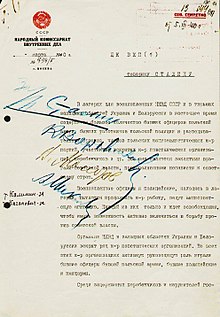
Those who died at Katyn included an admiral, two generals, 24 colonels, 79 lieutenant colonels, 258 majors, 654 captains, 17 naval captains, 3,420 NCOs, seven chaplains, three landowners, a prince, 43 officials, 85 privates, and 131 refugees. Also among the dead were 20 university professors (including Stefan Kaczmarz); 300 physicians; several hundred lawyers, engineers, and teachers; and more than 100 writers and journalists as well as about 200 pilots. In all, the NKVD executed almost half the Polish officer corps.[1] Altogether, during the massacre the NKVD murdered 14 Polish generals:[29] Leon Billewicz (ret.), Bronisław Bohatyrewicz (ret.), Xawery Czernicki (admiral), Stanisław Haller (ret.), Aleksander Kowalewski (ret.), Henryk Minkiewicz (ret.), Kazimierz Orlik-Łukoski, Konstanty Plisowski (ret.), Rudolf Prich (murdered in Lviv), Franciszek Sikorski (ret.), Leonard Skierski (ret.), Piotr Skuratowicz, Mieczysław Smorawiński and Alojzy Wir-Konas (promoted posthumously). A mere 395 prisoners were saved from the slaughter,[4] among them Stanisław Swianiewicz and Józef Czapski.[1] They were taken to the Yukhnov camp and then down to Gryazovets.[24]
Up to 99% of the remaining prisoners were subsequently murdered. People from the Kozelsk camp were murdered in the usual mass murder site of Smolensk countryside, in the Katyn forest; people from the Starobelsk camp were murdered in the inner NKVD prison of Kharkov and the bodies were buried near Piatykhatky; and police officers from the Ostashkov camp were murdered in the inner NKVD prison of Kalinin (Tver) and buried in Mednoye.[24]
Detailed information on the executions in the Kalinin NKVD prison was given during the hearing by Dmitrii Tokarev, former head of the Board of the District NKVD in Kalinin. According to Tokarev, the shooting started in the evening and ended at dawn. The first transport on 4 April 1940, carried 390 people, and the executioners had a hard time killing so many people during one night. The following transports were no greater than 250 people. The executions were usually performed with German-made 7,65 mm Walther PPK pistols supplied by Moscow, but 7.62x38R Nagant M1895 revolvers were also used.[30] The executioners used German weapons rather than the standard Soviet revolvers, as the latter were said to offer too much recoil, which made shooting painful after the first dozens of executions.[31] Vasili Mikhailovich Blokhin, chief executioner for the NKVD - and quite possibly the most prolific executioner in history - is reported to have personally shot and killed 7,000 of the condemned, some as young as 18, from the Oshtakov camp at Kalinin prison over a period of 28 days in April 1940.[28][32]
The killings were methodical. After the personal information of the condemned was checked, he was handcuffed and led to a cell insulated with a felt-lined door. The sounds of the murders were also masked by the operation of loud machines (perhaps fans) throughout the night. After being taken into the cell, the victim was immediately shot in the back of the head. His body was then taken out through the opposite door and laid in one of the five or six waiting trucks, whereupon the next condemned was taken inside. The procedure went on every night, except for the May Day holiday.[33]
After the executions, there were still more than 22,000 former Polish soldiers in NKVD labour camps. According to a report by Beria, on 2 November 1940 his department held two generals, 39 lieutenant-colonels and colonels, 222 captains and majors, 691 lieutenants, 4022 warrant officers and NCOs and 13,321 enlisted men captured during the Polish campaign. An additional 3,300 Polish soldiers were captured during the annexation of Lithuania, where they had been kept interned since September 1939.[34]
Some 3,000 to 4,000 Polish inmates of Ukrainian prisons and those from Belarus prisons were probably buried in Bykivnia and in Kurapaty respectively.[35] Porucznik Janina Lewandowska, daughter of Gen. Józef Dowbor-Muśnicki, was the only woman executed during the massacre at Katyn.[33][36][37]
[edit] Discovery


In 1942, Polish railroad workers found a mass grave at Katyn, and reported it to the Polish Secret State; the news was ignored, as people refused to believe the mass graves contained so many dead.[41] The fate of the missing prisoners remained unknown until April 1943 when the German Wehrmacht soldiers under Rudolf Christoph Freiherr von Gersdorff discovered the mass grave of 4,243 Polish military reserve officers in the forest on Goat Hill near Katyn.[42] Joseph Goebbels saw this discovery as an excellent tool to drive a wedge between Poland, Western Allies, and the Soviet Union. On 13 April, Berlin Radio broadcast to the world that German military forces in the Katyn forest near Smolensk had uncovered "a ditch ... 28 metres long and 16 metres wide [92 ft by 52 ft], in which the bodies of 3,000 Polish officers were piled up in 12 layers."[43] The broadcast went on to charge the Soviets with carrying out the massacre in 1940.

The Soviet government immediately denied the German charges and claimed that the Polish prisoners of war had been engaged in construction work west of Smolensk and consequently were captured and executed by invading German units in August 1941. The Soviet response on 15 April to the German initial broadcast of 13 April, prepared by the Soviet Information Bureau, stated that "[...]Polish prisoners-of-war who in 1941 were engaged in country construction work west of Smolensk and who [...] fell into the hands of the German-Fascist hangmen [...]."[9]
The Allies were aware that the Nazis had found a mass grave as the discovery transpired, through radio transmissions intercepted and decrypted by Bletchley Park. German experts and the international commission, which was invited by Germany, investigated the Katyn corpses and soon produced physical evidence that the massacre took place in early 1940, at a time when the area was still under Soviet control.[46]
In April 1943, when the Polish government-in-exile insisted on bringing the matter to the negotiation table with the Soviets and on an investigation by the International Red Cross,[46][47] Stalin accused the Polish government of collaborating with Nazi Germany, broke diplomatic relations with it,[48] and started a campaign to get the Western Allies to recognize the alternative Polish pro-Soviet government in Moscow led by Wanda Wasilewska.[49] Sikorski, whose uncompromising stance on that issue was beginning to create a rift between the Western Allies and the Soviet Union, died in an air crash two months later.
[edit] Soviet actions
Indeed, having retaken the Katyn area almost immediately after the Red Army had recaptured Smolensk, NKVD forces began a cover-up. A cemetery the Germans had permitted the Polish Red Cross to build was destroyed and other evidence removed.[1] In January 1944, the Soviet Union sent the "Special Commission for Determination and Investigation of the Shooting of Polish Prisoners of War by German-Fascist Invaders in Katyn Forest,"[9][50] headed by Nikolai Burdenko, the President of the Academy of Medical Sciences of the USSR, to investigate the incidents again. No foreign personnel were allowed to join the Commission.[1][9] The "Burdenko Commission" exhumed the bodies and concluded that all the shootings were done by German occupation forces in autumn 1941. The final report of the commission lists a number of items, from gold watches to letters and icons, allegedly found on the bodies. These items were said to have dates from November 1940 to June 1941, thus contradicting the German claim that the Poles were shot by the Soviets.[51]
[edit] Western response
The growing Polish-Soviet crisis was beginning to threaten Western-Soviet relations at a time when the Poles' importance to the Allies, significant in the first years of the war, was beginning to fade, due to the entry into the conflict of the military and industrial giants, the Soviet Union and the United States. In retrospective review of records, both British Prime Minister Winston Churchill and US President Franklin D. Roosevelt were increasingly torn between their commitments to their Polish ally, the uncompromising stance of Sikorski and the demands by Stalin and his diplomats.[citation needed]In private, Churchill agreed that the atrocity was likely carried out by the Soviets. According to Count Edward Raczyński, Churchill admitted on 15 April 1943 during a conversation with General Sikorski: "Alas, the German revelations are probably true. The Bolsheviks can be very cruel."[52] However, at the same time, on 24 April 1943 Churchill assured the Soviets: "We shall certainly oppose vigorously any 'investigation' by the International Red Cross or any other body in any territory under German authority. Such investigation would be a fraud and its conclusions reached by terrorism."[53] Unofficial or classified UK documents concluded that Soviet guilt was a "near certainty", but the alliance with the Soviets was deemed to be more important than moral issues; thus the official version supported the Soviet version, up to censoring the contradictory accounts.[46] Churchill's own post-war account of the Katyn affair gives little further insight. In his memoirs, he refers to the 1944 Soviet inquiry into the massacre, which found the Germans guilty and adds, "belief seems an act of faith."[54]
In the United States, a similar line was taken, notwithstanding that two official intelligence reports into the Katyn massacre were produced that contradicted the official position. In 1944 Roosevelt assigned his special emissary to the Balkans, Navy Lieutenant Commander George Earle, to produce a report on Katyn. Earle concluded that the massacre was committed by the Soviet Union. Having consulted with Elmer Davis, the director of the Office of War Information, Roosevelt rejected the conclusion (officially), declared that he was convinced of Nazi Germany's responsibility, and ordered that Earle's report be suppressed. When Earle formally requested permission to publish his findings, the President issued a written order to desist. Earle was reassigned and spent the rest of the war in American Samoa.[1]
A further report in 1945, supporting the same conclusion, was produced and stifled. In 1943, two US POWs – Lt. Col. Donald B. Stewart and Col. John H. Van Vliet – had been taken by Germans to Katyn for an international news conference.[55] Later, in 1945, Van Vliet submitted a report concluding that the Soviets were responsible for the massacre. His superior, Maj. Gen. Clayton Bissell, Gen. George Marshall's assistant chief of staff for intelligence, destroyed the report.[56] During the 1951–1952 Congressional investigation into Katyn, Bissell defended his action before Congress, arguing that it was not in the US interest to antagonize an ally whose assistance was still needed against the Empire of Japan.[1]

[edit] Judicial proceedings
From 28 December 1945 to 4 January 1946, seven servicemen of the German Wehrmacht were tried by a Soviet military court in Leningrad. One of them, Arno Diere, was charged with helping to dig the Katyn graves during the execution. Diere, who was accused of murder using machine-guns in Soviet villages, confessed to having taken part in burial (though not the execution) of 15-20 thousand Polish POWs in Katyn. For this he was spared execution and was given 15 years of hard labor. His confession was full of absurdities, and thus he was not used as a Soviet prosecution witness during the Nuremberg trials. In a note of 29 November 1954 he recanted his confession, claiming that he was forced to confess by the investigators. Contrary to a number of claims[57] of all the accused during the Leningrad Trial, only Diere was accused of a connection to the Katyn massacre.[58]At the London conference that drew up the indictments of German war crimes before the Nuremberg trials, the Soviet negotiators put forward the allegation, "In September 1941, 925 Polish officers who were prisoners of war were killed in the Katyn Forest near Smolensk." The US negotiators agreed to include it, but were "embarrassed" by the inclusion (noting that the allegation had been debated extensively in the press) and concluded that it would be up to the Soviets to sustain it.[59] At the trials in 1946, Soviet General Roman Rudenko, raised the indictment, stating that "one of the most important criminal acts for which the major war criminals are responsible was the mass execution of Polish prisoners of war shot in the Katyn forest near Smolensk by the German fascist invaders,"[60] but failed to make the case and the US and British judges dismissed the charges.[61] Also, it was not the purpose of the court to determine whether Germany or the Soviet Union was responsible for the crime, but rather to attribute the crime to at least one of the defendants, which the court was unable to do.[62]
[edit] Cold War views
In 1951 and 1952, in the background of the Korean War, a U.S. Congressional investigation chaired by Rep. Ray J. Madden and known as the Madden Committee investigated the Katyn massacre. It concluded that the Poles had been killed by the Soviets[1] and recommended that the Soviets be tried before the International Court of Justice.[55] Still, the question of responsibility remained controversial in the West as well as behind the Iron Curtain. In the United Kingdom in the late 1970s, plans for a memorial to the victims bearing the date 1940 (rather than 1941) were condemned as provocative in the political climate of the Cold War. It has been sometimes speculated that the choice made in 1969 for the location of the BSSR's war memorial at the former Belarusian village named Khatyn, a site of a 1943 Nazi massacre in which the entire village with its whole population was burned, have been made to cause confusion with Katyn.[63][64] The two names are similar or identical in many languages, and were often confused.[1][65]In Poland, the pro-Soviet authorities covered up the matter in concord with Soviet propaganda, deliberately censoring any sources that might provide information about the crime. Katyn was a forbidden topic in postwar Poland. Not only did government censorship suppress all references to it, but even mentioning the atrocity was dangerous. Yet if Katyn became erased from Poland's official history, erasing it from people's memory was impossible. In 1981, Polish trade union Solidarity erected a memorial with the simple inscription "Katyn, 1940" but it was confiscated by the police, to be replaced with an official monument "To the Polish soldiers – victims of Hitlerite fascism – reposing in the soil of Katyn". Nevertheless, every year on Zaduszki, similar memorial crosses were erected at Powązki cemetery and numerous other places in Poland, only to be dismantled by the police overnight. Katyn remained a political taboo in communist Poland until the fall of the Eastern bloc in 1989.[1]
[edit] Revelations
From the late 1980s, pressure was put not only on the Polish government, but on the Soviet one as well. Polish academics tried to include Katyn in the agenda of the 1987 joint Polish-Soviet commission to investigate censored episodes of the Polish-Russian history.[1] In 1989 Soviet scholars revealed that Joseph Stalin had indeed ordered the massacre, and in 1990 Mikhail Gorbachev admitted that the NKVD had executed the Poles and confirmed two other burial sites similar to the site at Katyn: Mednoye and Piatykhatky.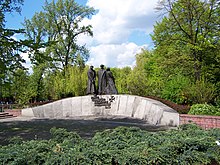
It isn't a personal pain which has brought me here, as is the case in the majority of these people, but rather recognition of the symbolic nature of Katyń. Russians and Poles, tortured to death, lie here together. It seems very important to me that the truth should be spoken about what took place, for only with the truth can the new Soviet leadership distance itself from the crimes of Stalin and the NKVD. Only the truth can serve as the basis of true friendship between the Soviet and the Polish peoples. The truth will make a path for itself. I am convinced of this by the very fact that I was able to travel here.[67]Brzezinski further stated that:
The fact that the Soviet government has enabled me to be here — and the Soviets know my views — is symbolic of the breach with Stalinism that perestroika represents.[68]His remarks were given extensive coverage on Soviet television. At the ceremony he placed a bouquet of red roses bearing a handwritten message penned in both Polish and English: "For the victims of Stalin and the NKVD. Zbigniew Brzezinski."[69]
On 13 April 1990, the forty-seventh anniversary of the discovery of the mass graves, the USSR formally expressed "profound regret" and admitted Soviet secret police responsibility.[12][70] The day was declared a worldwide Katyn Memorial Day (Polish: Światowy Dzień Pamięci Ofiar Katynia).[3]
After Poles and Americans discovered further evidence in 1991 and 1992, Russian President Boris Yeltsin released the top-secret documents from the sealed "Package №1." and transferred them to the new Polish president Lech Wałęsa,[1][71] Among the documents was a proposal by Lavrenty Beria dated with 5 March 1940[72] to execute 25,700 Poles from Kozelsk, Ostashkov and Starobels camps, and from certain prisons of Western Ukraine and Belarus, signed by Stalin (among others); an excerpt from the Politburo shooting order of 5 March 1940;[10] and Aleksandr Shelepin's 3 March 1959 note[27] to Nikita Khrushchev, with information about the execution of 21,857 Poles and with the proposal to destroy their personal files.
In 1991, the Chief Military Prosecutor for the Soviet Union began proceedings against P.K. Soprunenko for his role in the Katyn murders, but declined as Soprunenko was 83, almost blind and recovering from a cancer operation. During interrogation, he used the Kaltenbrunner defense - denying his own signature, etc.[28]
In June 1998, Yeltsin and Aleksander Kwaśniewski agreed to construct memorial complexes at Katyn and Mednoye, the two NKVD execution sites on Russian soil. However, in September of that year the Russians also raised the issue of Soviet prisoner of war deaths in the camps for Russian prisoners and internees in Poland (1919-1924). About 16,000 to 20,000 POWs died in those camps due to communicable diseases.[73][74] Some Russian officials argued that it was 'a genocide comparable to Katyń'.[1] A similar claim was raised in 1994; such attempts are seen by some, particularly in Poland, as a highly provocative Russian attempt to create an 'anti-Katyn' and 'balance the historical equation'.[75]
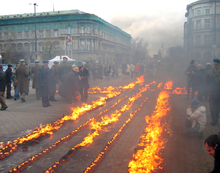
In March 2005 the Prosecutor's General Office of the Russian Federation concluded the decade-long investigation of the massacre. Chief Military Prosecutor Alexander Savenkov announced that the investigation was able to confirm the deaths of 1,803 out of 14,542 Polish citizens from three Soviet camps who had been sentenced to death.[77] He did not address the fate of about 7,000 victims who had been not in POW camps, but in prisons. Savenkov declared that the massacre was not a genocide, that Soviet officials who had been found guilty of the crime were dead and that, consequently, there is absolutely no basis to talk about this in judicial terms. 116 out of 183 volumes of files gathered during the Russian investigation, were declared to contain state secrets and were classified.[15][78]
[edit] In art and literature
| Katyn-Kharkiv memorial in Piatykhatky, Kharkiv Oblast Entry obelisk | Katyn-Kharkiv memorial in Piatykhatky, Kharkiv Oblast Rows of plaques for each officer buried here | Katyn-Kharkiv memorial in Piatykhatky, Kharkiv Oblast Commemorative plaque from the Polish people |
In 2000, US filmmaker Steven Fischer produced a public service announcement titled Silence of Falling Leaves honoring the fallen soldiers, consisting of images of falling autumn leaves with a sound track cutting to a narration in Polish by the Warsaw-born artist Bozena Jedrzejczak. It was honored with an Emmy nomination.[80]
The Academy Honorary Award recipient Polish film director Andrzej Wajda, whose father, Captain Jakub Wajda, was murdered in the NKVD prison of Kharkov, has made a film depicting the event, Katyn. The film recounts the fate of some of the women—mothers, wives and daughters—of the Polish officers slaughtered by the Soviets. Some Katyn Forest scenes are re-enacted. The screenplay is based on Andrzej Mularczyk's book Post mortem - the Katyn story. The film was produced by Akson Studio, and released in Poland on 21 September 2007. In 2008 it was nominated for the Academy Award for the Best Foreign Language Film.
[edit] Recent developments
In 2008, British historian Laurence Rees produced a 6-hour prime time BBC / PBS television documentary series entitled World War II Behind Closed Doors: Stalin, the Nazis and the West. The Katyn massacre was a central theme.[81] Rees said he wanted to bring a fresh way of looking at Second World War history to the British and American public.[82] In 2009, Rees published an accompanying book, in which he concluded:particularly in relation to Poland, the immorality of the Soviet Union tainted the actions of the Western leaders. The Western Allies' treatment of the Poles was unworthy: from the cover-up over Katyn to the secret deal at Tehran that eventually shifted Polish borders without the consent of the Poles; from the meeting in Moscow when Churchill accused members of the Polish government in exile of being 'callous people who want to wreck Europe', to the exclusion of Polish troops in the Victory Parade in London in 1946. It is a sad catalogue - and one I certainly wasn't taught in school when I was told that we should all only 'feel good' about the conduct of the Western Allies in the Second World War. ... The central popular myth that surrounds the war, a kind of Hollywood version of the history, is that it is a simple story of an alliance of good people who fought an alliance of bad people. It's an immensely consoling way of looking at the past, and it's sad to let it go. But let it go we must.[83]On 24 April 2009, Adam Michnik, the editor-in-chief of Gazeta Wyborcza, wrote an essay on the French Left and its views on Katyn massacre, and linked it to perceptions of Polish anti-Semitism.[84] He wrote:
"Katyn" is the first film about the Soviet crimes and its aggression against Poland, committed in alliance with Hitler. This issue has been a taboo for the French Left. For years they were silent about the Soviet aggression against Poland and about Soviet atrocities; they were also silent about Katyn. This massacre is still the skeleton in the cupboard of the French Left that has shown such understanding for Stalin, the Great Linguist. This is not the only dogma of left-wing hypocrisy. The other one is the conviction that all Poles have soaked up anti-Semitism with their mothers’ milk and that Jews were the only victims of the German occupation. I learned from "Le Monde" that "Wajda presents a strange confusion of the Katyn crime with the extermination of the Jews". And by contrast, the film "includes scenes of hunting and persecution of Polish officers presenting them as if they were deportations of Jews to death camps".[85]A number of pro-Soviet Russian politicians and commentators and Communist party members continue to deny all Soviet guilt, call the released documents fakes, and insist that the original Soviet version – Polish prisoners were shot by Germans in 1941 – is the correct one.[86][87][88]
On the opposing sides there are allegations that the massacre was part of wider action coordinated by both Nazi Germany and the Soviet Union, or that the Germans at least knew of Katyn beforehand.[citation needed] These allegations cite the secret supplementary protocol[89] to the German-Soviet Boundary and Friendship Treaty, which stipulates that "Both parties will tolerate in their territories no Polish agitation which affects the territories of the other party. They will suppress in their territories all beginnings of such agitation and inform each other concerning suitable measures for this purpose". They also describe a series of conferences between the NKVD and Gestapo, organised in the town of Zakopane in 1939–1940, and claim that these conferences were held to coordinate the killing and the deportation policy[90] and exchange experience. Writing in the Commentary magazine in 1981, George Watson, a Fellow in English at St. John's College, Cambridge suggested that the fate of Polish prisoners may have been discussed at the April 1940 conference.[91]
In late 2007 and early 2008, several Russian newspapers, including Rossiyskaya Gazeta, Komsomolskaya Pravda and Nezavisimaya Gazeta printed stories that implicated the Nazis for the crime, spurring concern that this was done with the tacit approval of the Kremlin.[88] As a result, the Polish Institute of National Remembrance decided to open its own investigation.[4] Prosecution team head Leon Kieres said they would try to identify those involved in ordering and carrying out the killings. In addition, on 22 March 2005 the Polish Sejm unanimously passed an act, requesting the Russian archives to be declassified.[92] The Sejm also requested Russia to classify the Katyn massacre as a crime of genocide.[93] The resolution stressed that the authorities of Russia "seek to diminish the burden of this crime by refusing to acknowledge it was genocide and refuse to give access to the records of the investigation into the issue, making it difficult to determine the whole truth about the murder and its perpetrators."[94]
Russia and Poland remained divided on the legal description of the Katyn crime, with the Poles considering it a case of genocide and demanding further investigations, as well as complete disclosure of Soviet documents.[94][95] In 2008, Polish Foreign Ministry asked the government of Russia about alleged footage of the massacre filmed by the NKVD during the killings. Polish officials believe that this footage, as well as further documents showing cooperation of Soviets with the Gestapo during the operations, are the reason for Russia's decision to classify most of documents about the massacre.[96]
In June 2008, Russian courts consented to hear a case about the declassification of documents about Katyn and the judicial rehabilitation of the victims. In an interview with a Polish newspaper, Vladimir Putin called Katyn a "political crime."[97]
The European Court of Human Rights communicated the Katyn claims to the Russian government on 10 October 2008.[98]
On 4 February 2010 the Prime Minister of Russia, Vladimir Putin, invited his Polish colleague, Donald Tusk, to attend a Katyn memorial in April.[99] The visit took place on 7 April 2010, when Tusk and Putin together commemorated the 70th anniversary of the massacre.[100] Before the visit, the 2007 film Katyń was shown on Russian state television for the first time. The Moscow Times commented that the film's premiere in Russia was likely a result of Putin's intervention.[101]
On 10 April 2010, a plane carrying Polish President Lech Kaczyński with his wife and 87 other politicians and high-ranking army officers crashed in Smolensk, killing all 96 aboard the plane.[102] The passengers were to attend a ceremony marking the 70th anniversary of the Katyn massacre. The catastrophe has had major echoes in the international and notably Russian press, prompting, in particular, a rebroadcast of Katyń on Russian television.[103]
The Polish President, Lech Kaczyński was to deliver a speech at the formal commemorations. The speech was to honour the victims, highlight the significance of the massacres in the context of postwar communist political history, as well as stress the need for Polish-Russian relations to focus on reconciliation. Although the speech was never delivered, it has been published with a narration in the original Polish[104] and a translation has also been made available in English.[105]
On 21 April 2010, it was reported that the Russian Supreme Court ordered the Moscow City Court to hear an appeal in an ongoing Katyn legal case.[106] A civil rights group, Memorial, said the ruling could lead to a court decision to open up secret documents providing details about the killings of thousands of Polish officers.[106]
On 8 May 2010, Russia handed over to Poland 67 volumes of the "criminal case No.159," launched in the 1990s to investigate the Soviet-era mass killings of Polish officers. The copies of 67 volumes, each having about 250 pages, were packed in six boxes. With each box weighting approximately 12 kg (26.5 lbs), the total weight of all the documents stood at about 70 kg (153 lbs). Russian President Dmitry Medvedev handed one of the volumes to the acting Polish president, Bronislaw Komorowski. Medvedev and Komorowski agreed that the two states should continue their efforts in revealing the truth over the tragedy. The Russian president reiterated that Russia would continue declassifying documents on the Katyn massacre. The acting Polish president said that Russia's move might lay a good foundation for improving bilateral relations.[107]
[edit] Memorials

In Cannock Chase, Staffordshire, UK, a memorial to the victims of the Katyn Massacre was unveiled by Stefan Staniszewski, whose father Hillary Zygmunt Staniszewski (a high court judge) died in the massacre. Preserved below a small stone monument bearing a plaque with the inscription "In memoriam to the 14,000 members of the Polish Armed Forces and professional classes who were executed in Katyn Forest (1940)" are phials of soil from both Warsaw and the Katyn forest.[109] A Katyn memorial is also situated in the grounds of the Clifton Cathedral in Bristol.
A golden statue, known as the National Katyn Massacre Memorial, is located in Baltimore, Maryland, United States, on Aliceanna Street at Inner Harbor East.[110] Polish-Americans in Detroit erected a small white-stone memorial in the form of a cross with plaque at the St. Albertus Roman Catholic Church.[111] A statue commemorating the massacre is erected at Exchange Place on the Hudson River in Jersey City, New Jersey.[112]
A large metal sculpture has been erected in the Polish community of Roncesvalles in Toronto, Ontario, to commemorate the killings.
A memorial in Johannesburg, South Africa, commemorates the victims of Katyn as well as South African and Polish airmen who flew missions to drop supplies for the Warsaw Uprising.[113]
A memorial complex was erected to honor the over 4300 officer victims of the Katyn massacre murdered in Pyatykhatky, 14 kilometres (8.7 mi) north of Kharkiv in Ukraine; the memorial complex lies in a corner of a former resort home for NKVD officers. Children had discovered hundreds of Polish officer buttons whilst playing on the site. After excavation, the bodies were reburied with an alley of plaques, one for each of the officers shot there, stating their name, rank and town of origin. The monument is made of steel and is constantly red from rusting, evoking the blood shed by the officers. A bell sunk into the ground tolls on the hour.
In Wroclaw, in Poland, a powerful composition created in 1999 by Polish sculptor Tadeusz Tchorzewski in a park east of the centre (near the city's Raclawice Panorama building) is dedicated to those killed at Katyn. It shows (all as life-size figures) a mother cradling her dead soldier son's head to her breast, whilst on a separate higher plinth the angel of death looms over, leaning forward omenously, leaning on a sword.
[edit] Original documents
Authenticated copies of Soviet documents related to the Katyn massacre. The second paper is an execution order, signed by Stalin, Vyacheslav Molotov, Kliment Voroshilov, Anastas Mikoyan.[edit] See also
- 1943 Aircraft crash of Polish prime minister Sikorski
- Mass graves in the Soviet Union
- NKVD prisoner massacres
- Polish prisoners of war in the Soviet Union (after 1939)
- Soviet repressions of Polish citizens (1939–1946)
- World War II crimes in Poland
- Zdzisław Peszkowski - Roman Catholic priest and leading advocate for survivors and families of the Katyn
- Litene, notorious for murder of the Latvian Army officers by NKVD in June 1941.
- Tuchola
